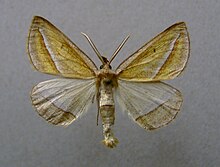Chariaspilates formosaria
| Chariaspilates formosaria | ||||||||||||
|---|---|---|---|---|---|---|---|---|---|---|---|---|

Chariaspilates formosaria , female |
||||||||||||
| Systematics | ||||||||||||
|
||||||||||||
| Scientific name | ||||||||||||
| Chariaspilates formosaria | ||||||||||||
| ( Eversmann , 1837) |
Chariaspilates formosaria , sometimes also referred to as moor meadow welted spanner , is a butterfly ( moth ) fromthe spanner family (Geometridae).
features
butterfly
There is a slight sexual dimorphism between the sexes . The wingspan of the females is 38 to 43 millimeters, that of the smaller males 31 to 37 millimeters. The forewings of female moths are elongated and sharply pointed at the apex , while those of males are shorter and usually more rounded. Both sexes show a golden yellow basic color, which is partially dusted brown. Starting from the wing tip, a dark transverse line runs diagonally to the center of the inner edge, which is light on the inside. In addition, an often poorly developed, black center can be seen. The front edge is lightened. There is a straight brown transverse line on the whitish hind wings. The hem area is slightly darkened. All the fringes have a brownish shimmer. The antennae of the males are combed short on both sides, those of the females are slightly sawtooth.
egg
The round egg initially has a honey-yellow color, which later changes to vermilion.
Caterpillar
Adult caterpillars are brown to purple-gray in color, mixed with light marbling. A black back line is only on the front segments. The bright side stripe is wide.
Doll
The doll is colored glossy black-brown and shows two conical tips on the cremaster , each of which shows a small tooth on the outside.
Geographical distribution and occurrence
Chariaspilates formosaria occurs very locally in a few boggy areas in Europe and is also found sporadically in Japan . The species inhabits fens, swampy meadows and riparian areas.
Way of life
The main flight time for the moths is June and July. In breeding, a second generation can also be reached, which is called C. formosaria f.autumnalis peacock and hatches in September or October. The caterpillars live in nature from August, overwinter and pupate in May of the following year. They prefer to feed on Gagel ( Myrica gale ) or common loosestrife ( Lysimachia vulgaris ). When breeding, they also accept marsh marigolds ( Caltha palustris ).
Danger
Of the German federal states, Chariaspilates formosaria can only be found in Mecklenburg-Western Pomerania , very locally in the Anklamer Stadtbruch nature reserve . The species is listed in Category 1 (critically endangered) on the Red List of Threatened Species .
Subspecies
The following subspecies are known:
- Chariaspilates formosaria formosaria
- Chariaspilates formosaria andriana
- Chariaspilates formosaria pannonicus
swell
Individual evidence
- ^ A b Walter Forster, Theodor A. Wohlfahrt: The butterflies of Central Europe. Volume 5: Spanner. (Geometridae). Franckh'sche Verlagshandlung, Stuttgart 1981, ISBN 3-440-04951-5 .
- ↑ a b Manfred Koch , Wolfgang Heinicke, Bernd Müller: We determine butterflies. Volume 4: Spanner. 2nd, improved and enlarged edition. Neumann, Leipzig / Radebeul 1976, DNB 780451570 .
- ↑ Ernst and Herta Urbahn: The butterflies of Pomerania with a comparative overview of the Baltic Sea region. Entomological Association in Stettin, Stettin 1939.
- ↑ Federal Agency for Nature Conservation (Ed.): Red List of Endangered Animals in Germany . Landwirtschaftsverlag, Münster 1998, ISBN 3-89624-110-9 .
literature
- Walter Forster , Theodor A. Wohlfahrt : The butterflies of Central Europe. Volume 5: Spanner. (Geometridae). Franckh'sche Verlagshandlung, Stuttgart 1981, ISBN 3-440-04951-5 .
Web links
- www.Lepiforum e. V. Taxonomy and Photos
- www.lepidoptera.pl Occurrence in Europe
- www.discoverlife.org Occurrence worldwide
- www.lung.mv-regierung.de (PDF; 7.8 MB) Landscape framework plan Vorpommern 2009
- Chariaspilates formosaria in Fauna Europaea. Retrieved November 4, 2011
